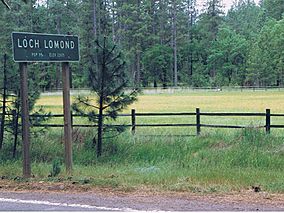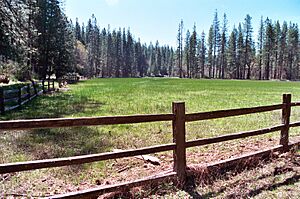Loch Lomond Vernal Pool Ecological Reserve facts for kids
Quick facts for kids Loch Lomond Vernal PoolEcological Reserve |
|
|---|---|
|
IUCN Category Ia (Strict Nature Reserve)
|
|
 |
|
| Location | Southern Lake County, California |
| Nearest city | Lower Lake, California |
| Area | 8 acres (32,000 m2) |
| Established | 1988 |
| Governing body | California Department of Fish and Game |
The Loch Lomond Vernal Pool Ecological Reserve is a special nature area in Lake County, California. It covers about 8.22 acres (33,300 m2) of land. This reserve is one of 119 similar places managed by the California Department of Fish and Game (CDFG). These reserves were created in 1968 to protect rare plants, animals, and their natural homes.
A very important part of this reserve is its vernal pool. A vernal pool is a shallow pond that fills with water in the rainy season and then dries up. This unique habitat is home to a rare and endangered plant called the Loch Lomond button celery. This plant is also known as coyote-thistle.
The button celery was first found here in 1941. For many years, this was the only known place it grew. Later, in the late 1990s, a few more groups of this plant were discovered in Lake County and Sonoma County.
The reserve is located in the southern part of Lake County, within the Mayacamas Mountains. These mountains are part of the California Coast Ranges. Nearby, Cobb Mountain stands tall at 4,722 feet, making it the highest peak in the area. Even though this area was heavily logged in the past, it still has many trees. You can find Ponderosa pine, sugar pine, and Douglas fir trees here. There are also black oak trees. Smaller plants like manzanita, ground rose, coffeeberry, and California lilac grow beneath the trees.
Protecting the Loch Lomond Button Celery
The Loch Lomond button celery is a very special plant. In 1985, it was listed as endangered under the federal Endangered Species Act. This was an emergency step to save it. The plant was in danger because people planned to dig up and fill in its vernal pool home.
To protect the plant, the California Department of Fish and Game bought the land on March 28, 1988. They paid $46,000 for it, using money from the state. After buying the land, they put up a fence. This fence helps to keep people from accidentally harming the reserve.
Before it became a reserve, this area was used for many fun activities. People played baseball, rode horses, and even ice-skated here. It was also next to the Loch Lomond Lodge, a popular resort. Sadly, the lodge was destroyed by a fire in 1967.
Discovering the Button Celery
The first person to collect a sample of the button celery was Robert Hoover in 1941. Later, in 1973, botanist Lincoln Constance and M. Yusuf Sheikh also collected samples. The plant is named after Lincoln Constance.
M. Yusuf Sheikh searched many other areas for the button celery. He was doing this for his doctoral studies. However, he could not find any other groups of the plant. In 1984, California state botanists also looked for more plants, but they had no luck either.
Because the plant was so rare, the US Fish and Wildlife Service (USFWS) took emergency action in August 1985. They officially listed the button celery as endangered. This was done to stop the plant from possibly disappearing forever. At that time, the reserve was the only known place where the plant lived. Since the 1990s, three more groups of the plant have been found.
The emergency listing ended in March 1986. The USFWS then made a new proposal to protect the plant. They asked the public for their thoughts. Finally, on January 22, 1987, the button celery was officially listed as an Endangered plant by the federal government.
The person who owned the land before was planning to build a pool or lake there. They had already started digging. So, the disturbed area was smoothed out and new button celery seeds were planted. Other dangers to the plant included off-road vehicles, people walking through the meadow, and illegal dumping of trash.
Even today, off-road vehicles can be a problem during the rainy season. In 2009, the Department of Fish and Game was looking into putting up new fences to better protect the area.
Other Rare Plants in the Reserve
The Loch Lomond Vernal Pool Ecological Reserve is also home to other rare plants.
- Many-flowered navarretia (Navarretia leucocephala ssp. plieantha)
This plant is listed as endangered by both the state (since 1979) and federal government (since 1997). It grows in wet areas near Ponderosa pine forests. This annual wildflower is part of the Phlox family (Polemoniaceae). It has only been found in Lake, Sonoma, and Napa counties in California.
The many-flowered navarretia grows as a flat mat on the ground. Its flowers are white or blue and grow in clusters. They bloom from May through June. It can be hard to identify this plant. It looks very similar to the few-flowered navarretia and Baker's navarretia. It can even mix with the few-flowered navarretia to create new types.
- Few-flowered navarretia (Navarretia leucocephala ssp. pauciflora)
This plant is also listed as endangered by the state (since 1990) and federal government (since 1997). It is very similar to the many-flowered navarretia. However, its white or blue flowers are smaller. Also, its plant stems are white with purple stripes.
According to the US Fish and Wildlife Service, only Napa County still has a group of few-flowered navarretia plants. In the past, these plants were found at the Loch Lomond reserve, Boggs Lake reserve, and in Sonoma County.


